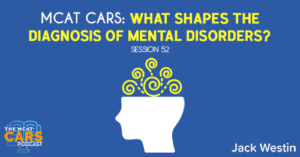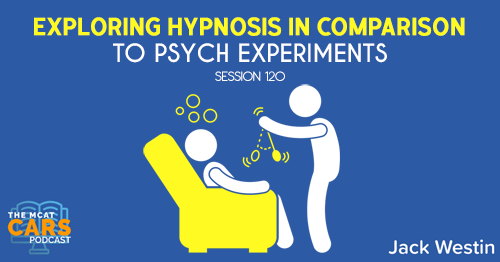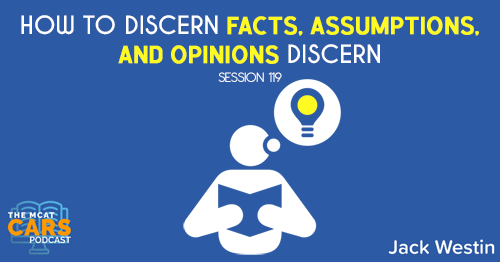Apple Podcasts | Google Podcasts

Session 52
What is the pathogenesis of mental illness? Follow along as we dive into a passage loaded with differing viewpoints, history, and context. As always, we’re joined by Jack Westin, the leader in the MCAT prep world.
Link to article:
https://www.newyorker.com/magazine/2019/05/27/the-troubled-history-of-psychiatry
Modern medicine can be seen as a quest to understand pathogenesis, the biological cause of an illness. Once pathogenesis—the word comes from the Greek pathos (suffering) and genesis (origin)—has been established by scientific experiment, accurate diagnoses can be made, and targeted therapies developed. In the early years of the aids epidemic, there were all kinds of theories about what was causing it: toxicity from drug use during sex, allergic reactions to semen, and so on. Only after the discovery of the human immunodeficiency virus helped lay such conjectures to rest did it become possible to use specific blood tests for diagnosis and, eventually, to provide antiviral drugs to improve immune defenses.
Sometimes a disease’s pathogenesis is surprising. As a medical student, I was taught that peptic ulcers were often caused by stress; treatments included bed rest and a soothing diet rich in milk. Anyone who had suggested that ulcers were the result of bacterial infection would have been thought crazy. The prevailing view was that no bacterium could thrive in the acidic environment of the stomach. But in 1982 two Australian researchers (who later won a Nobel Prize for their work) proposed that a bacterium called Helicobacter pylori was crucial to the onset of many peptic ulcers. Although the hypothesis was met with widespread scorn, experimental evidence gradually became conclusive. Now ulcers are routinely healed with antibiotics.
But what can medicine do when pathogenesis remains elusive? That’s a question that has bedevilled the field of psychiatry for nearly a century and a half. In “Mind Fixers” (Norton), Anne Harrington, a history-of-science professor at Harvard, follows “psychiatry’s troubled search for the biology of mental illness,” deftly tracing a progression of paradigms adopted by neurologists, psychiatrists, and psychologists, as well as patients and their advocates.
Her narrative begins in the late nineteenth century, when researchers explored the brain’s anatomy in an attempt to identify the origins of mental disorders. The studies ultimately proved fruitless, and their failure produced a split in the field. Some psychiatrists sought nonbiological causes, including psychoanalytic ones, for mental disorders. Others doubled down on the biological approach and, as she writes, “increasingly pursued a hodgepodge of theories and projects, many of which, in hindsight, look both ill-considered and incautious.” The split is still evident today.
The history that Harrington relays is a series of pendulum swings. For much of the book, touted breakthroughs disappoint, discredited dogmas give rise to counter-dogmas, treatments are influenced by the financial interests of the pharmaceutical industry, and real harm is done to patients and their loved ones. One thing that becomes apparent is that, when pathogenesis is absent, historical events and cultural shifts have an outsized influence on prevailing views on causes and treatments. By charting our fluctuating beliefs about our own minds, Harrington effectively tells a story about the twentieth century itself.
[02:52] Paragraph 1, Sentence 1
Modern medicine can be seen as a quest to understand pathogenesis, the biological cause of an illness.
Jack says:
The author defines modern medicine which is this quest to understand pathogenesis.
[03:16] Paragraph 1, Sentence 2
Once pathogenesis—the word comes from the Greek pathos (suffering) and genesis (origin)—has been established by scientific experiment, accurate diagnoses can be made, and targeted therapies developed.
Jack says:
The author is painting a picture of why we need to understand pathogenesis. It’s pretty clear. But this is tough for the non-science or non-medicine student. Premeds love this and thismay make sense to them. But this is not easy to understand sometimes.
[04:00] Paragraph 1, Sentence 3
In the early years of the aids epidemic, there were all kinds of theories about what was causing it: toxicity from drug use during sex, allergic reactions to semen, and so on.
Jack says:
The author gives an example of AIDS and that we didn’t have the pathogenesis so we were just guessing. This sounds ridiculous now because we know it. But at soe point, we had no idea how you acquired it.
[04:39] Paragraph 1, Sentence 4
Only after the discovery of the human immunodeficiency virus helped lay such conjectures to rest did it become possible to use specific blood tests for diagnosis and, eventually, to provide antiviral drugs to improve immune defenses.
Jack says:
The author is laying out the first sentence of this paragraph about modern medicine. Once we have the diagnosis, we can diagnose and we can treat. The key is to understand the cause of the disease in order to treat it.
[05:28] Paragraph 2, Sentence 1
Sometimes a disease’s pathogenesis is surprising.
Jack says:
It’s a little fun twist here. Let’s keep on reading.
[05:47] Paragraph 2, Sentence 2
As a medical student, I was taught that peptic ulcers were often caused by stress; treatments included bed rest and a soothing diet rich in milk.
Jack says:
The author is talking about peptic ulcers and what they used to do for treatment.
[06:14] Paragraph 2, Sentence 3
Anyone who had suggested that ulcers were the result of bacterial infection would have been thought crazy.
Jack says:
There were people suggesting a different pathogenesis but they were considered crazy. A lot of students reading this would have no idea why it would be crazy to suggest a bacterial infection. It doesn’t matter if you don’t understand this but what you need to understand is that some things were not considered.
[07:02] Paragraph 2, Sentence 4
The prevailing view was that no bacterium could thrive in the acidic environment of the stomach.
Jack says:
So this is why people were considered crazy because this can’t happen.
[07:13] Paragraph 2, Sentence 5
But in 1982 two Australian researchers (who later won a Nobel Prize for their work) proposed that a bacterium called Helicobacter pylori was crucial to the onset of many peptic ulcers.
Jack says:
The author mentions how two researchers were proposing this specific bacteria.
[07:42] Paragraph 2, Sentence 6
Although the hypothesis was met with widespread scorn, experimental evidence gradually became conclusive.
Jack says:
The word “scorn” here probably goes back to people thinking you’re crazy. Then the evidence is becoming conclusive, meaning they’re proving that this bacteria is causing peptic ulcer.
[08:14] Paragraph 2, Sentence 7
Now ulcers are routinely healed with antibiotics.
Jack says:
It’s surpising what causes these diseases. It’s still going back to what we’re talking about in the first paragraph. The biological cause of the illness is still the key here.
[09:33] Paragraph 3, Sentences 1-2
But what can medicine do when pathogenesis remains elusive? That’s a question that has bedevilled the field of psychiatry for nearly a century and a half.
Jack says:
Another twisst here as we’re going into Psychiatry. By bedeviled, it probably means something bad lookin at the word “devil.”
[10:25] Paragraph 3, Sentence 3
In “Mind Fixers” (Norton), Anne Harrington, a history-of-science professor at Harvard, follows “psychiatry’s troubled search for the biology of mental illness,” deftly tracing a progression of paradigms adopted by neurologists, psychiatrists, and psychologists, as well as patients and their advocates.
Jack says:
The author is highlighting a book written by Harrington. The words here might be difficult to understand but don’t focus on one word here.
“The context matters. Don’t worry about one word. Keep reading. Try to get the context.Try to get the point of the sentence.”
[12:17] Paragraph 4, Sentence 1
Her narrative begins in the late nineteenth century, when researchers explored the brain’s anatomy in an attempt to identify the origins of mental disorders.
Jack says:
The author says the writer is talking about the narrative of the book.
[12:49] Paragraph 4, Sentence 2
The studies ultimately proved fruitless, and their failure produced a split in the field.
Jack says:
The research looking at anatomy trying to find out the origins of mental disorders failed. And there was a split.
[13:10] Paragraph 4, Sentence 3
Some psychiatrists sought nonbiological causes, including psychoanalytic ones, for mental disorders.
Jack says:
Some psychiatrists are doing one thing here.
[13:25] Paragraph 4, Sentence 4
Others doubled down on the biological approach and, as she writes, “increasingly pursued a hodgepodge of theories and projects, many of which, in hindsight, look both ill-considered and incautious.”
Jack says:
So many difficult words here. But the language here isn’t very good. But we still don’t really know.
[14:14] Paragraph 4, Sentence 5
The split is still evident today.
Jack says:
So we still don’t know here as some people think one way and others think the other. It’s interesting to point out here that we’ve figured out where some important diseases come from. Then there are these mental disorders that we can’t necessary pinpoint exactly. So we still have this issue.
[14:48] Paragraph 5, Sentence 1
The history that Harrington relays is a series of pendulum swings.
Jack says:
The author is talking more about Harrington and her book. By “pendulum swings,” visualize what a pendulum does when it’s swinging. Relate this to what we’re discussing. Then you have a better idea of the author’s point of view.
What the author is trying to convey is that we just don’t know. And the pendulum swinging is the analogy where the swing suggests that we’re not sure.
[15:51] Paragraph 5, Sentence 2
For much of the book, touted breakthroughs disappoint, discredited dogmas give rise to counter-dogmas, treatments are influenced by the financial interests of the pharmaceutical industry, and real harm is done to patients and their loved ones.
Jack says:
The author is describing the book more here. This is a loaded sentence. It’s trying to reinforce the fact that pathogenesis is important. We need that. It’s a necessary thing for us to pinpoint the disease and treat it.
Then the pharmaceutical industry is creating treatments for diseases that we don’t know what causing them. So how can you create the treatment? They’re just trying to make money.
[17:35] Paragraph 5, Sentence 3
One thing that becomes apparent is that, when pathogenesis is absent, historical events and cultural shifts have an outsized influence on prevailing views on causes and treatments.
Jack says:
The author suggest that when we don’t know what’s going on, so much of medicine influences how we view what’s going on medically, the causes, and treatments. If we don’t have science that can back something, we depend on other means.This is an opinion that you need to stick to.
[19:45] Paragraph 5, Sentence 4
By charting our fluctuating beliefs about our own minds, Harrington effectively tells a story about the twentieth century itself.
Jack says:
There is so much more to the article here but we’re not going to read it. But so far, what the uathor is trying to convey here is that they defined something. They want you to understand through examples of it. They also gave an example of what’s not possible and how that’s bad. So this is the structure of this passage.
At the very end, they’re starting to go into this idea of culture and how maybe this shows some clues on how our culture works. But this is not important. You need to know the bigger picture here where pathogenesis is not possible for mental health diagnosis and that’s a problem.
Links:
Link to article:
https://www.newyorker.com/magazine/2019/05/27/the-troubled-history-of-psychiatry
SEARCH SITE
SEARCH SITE
LISTEN FOR FREE











